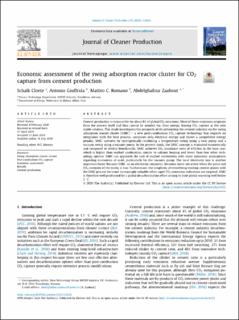| dc.contributor.author | Cloete, Schalk Willem Petrus | |
| dc.contributor.author | Giuffrida, Antonio | |
| dc.contributor.author | Romano, Matteo C. | |
| dc.contributor.author | Zaabout, Abdelghafour | |
| dc.date.accessioned | 2022-10-10T11:58:19Z | |
| dc.date.available | 2022-10-10T11:58:19Z | |
| dc.date.created | 2021-02-11T09:44:34Z | |
| dc.date.issued | 2020 | |
| dc.identifier.citation | Journal of Cleaner Production, 275, 123024, 1-16 | en_US |
| dc.identifier.issn | 0959-6526 | |
| dc.identifier.uri | https://hdl.handle.net/11250/3025099 | |
| dc.description.abstract | Cement production is responsible for about 8% of global CO2 emissions. Most of these emissions originate from the process itself and thus cannot be avoided via clean energy, leaving CO2 capture as the only viable solution. This study investigates the prospects of decarbonizing the cement industry via the swing adsorption reactor cluster (SARC) – a new post-combustion CO2 capture technology that requires no integration with the host process, consumes only electrical energy and shows a competitive energy penalty. SARC operates by synergistically combining a temperature swing using a heat pump and a vacuum swing using a vacuum pump. In the present study, the SARC concept is evaluated economically and compared to several benchmarks. SARC achieves CO2 avoidance costs of €52/ton in the base case, which is higher than oxyfuel combustion, similar to calcium looping and lower than four other technology options. SARC can approach the cost of oxyfuel combustion with more optimistic assumptions regarding economies of scale, particularly for the vacuum pump. The local electricity mix is another important factor because SARC, as an electricity consumer, becomes more attractive when the price and CO2 intensity of electricity is low. Furthermore, the simplicity of retrofitting existing cement plants with the SARC process becomes increasingly valuable when rapid CO2 emissions reductions are targeted. SARC is therefore well positioned for a global decarbonization effort aiming to limit global warming well below 2 °C. | en_US |
| dc.language.iso | eng | en_US |
| dc.publisher | Elsevier | en_US |
| dc.rights | Navngivelse 4.0 Internasjonal | * |
| dc.rights.uri | http://creativecommons.org/licenses/by/4.0/deed.no | * |
| dc.subject | Cement production | en_US |
| dc.subject | Retrofit | en_US |
| dc.subject | Economic assessment | en_US |
| dc.subject | CO2 capture | en_US |
| dc.subject | Post-combustion | en_US |
| dc.subject | Swing adsorption reactor cluster | en_US |
| dc.title | Economic assessment of the swing adsorption reactor cluster for CO2 capture from cement production | en_US |
| dc.type | Peer reviewed | en_US |
| dc.type | Journal article | en_US |
| dc.description.version | publishedVersion | en_US |
| dc.rights.holder | © 2020 The Author(s). Published by Elsevier Ltd | en_US |
| dc.source.pagenumber | 16 | en_US |
| dc.source.volume | 275 | en_US |
| dc.source.journal | Journal of Cleaner Production | en_US |
| dc.identifier.doi | 10.1016/j.jclepro.2020.123024 | |
| dc.identifier.cristin | 1888741 | |
| dc.source.articlenumber | 123024 | en_US |
| cristin.ispublished | true | |
| cristin.fulltext | original | |
| cristin.qualitycode | 2 | |

